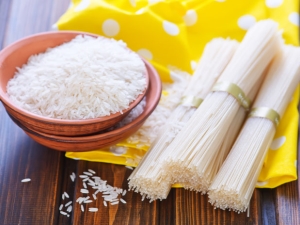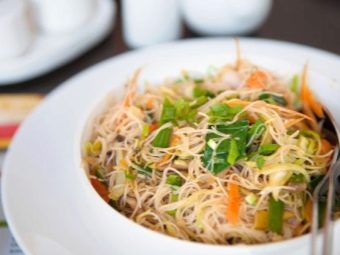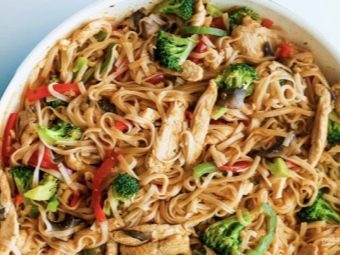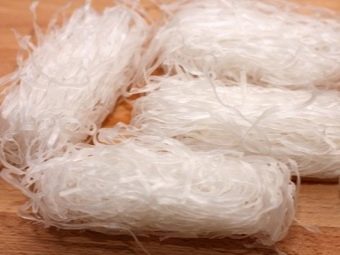Calorie and nutritional value of rice noodles

Rice is eaten daily by millions of people. And to diversify it, invented a number of interesting options. One of them is rice noodles.
Features and chemical composition
The calorie content of rice noodles that has not been cooked is 363 calories per 100 grams. In the same volume of product is present:
- 81 g of carbohydrates;
- 3.4 g of proteins;
- just over 0.5 grams of fat.
This type of food is rich in vitamins of group D, there is also a significant amount of vitamin E. Of the inorganic components draw attention to themselves:
- potassium;
- iron;
- phosphorus;
- manganese;
- calcium.
After cooking
Even an inexperienced person will easily understand that, by the number of kcal, raw rice noodles can hardly be called the standard of dietary nutrition. But everything changes when it is boiled. Rice boiled noodles in finished form have an energy value of only 120 kcal per 100 g. There is nothing supernatural about this: just a portion of boiled noodles are saturated with water, this is ordinary broth.
Useful or not?
Calorie to know is very important, no one argues with this. But to evaluate the usefulness of the product only for it is impossible. And with the benefits of just rice noodles, everything is in order. Even the small amount of protein that is included in the BJU formula does not include gluten. Therefore, the risk of gastric malfunction and the appearance of food allergy is minimal. Fiber is completely absent in rice noodles.
Increased concentration of vitamin E helps to promote health and maintain a young skin. And vitamins from group B are valuable for effective support of the nervous system. They also prove to be quite good antioxidants.
The relatively low nutritional value of the product allows us to recommend it as a replacement for classic pasta. Yes, it supplies the body with a large amount of carbohydrates. But they all belong to the “complex” group, that is, they split for a long time, stabilizing the energy balance.
What's more important, all these carbohydrates will not affect the glycemic index of nutrition. Therefore, they can be safely consumed both by patients with diabetes and those who have a predisposition to this disease.
With regard to the risk associated with the use of rice noodles, for the most part the product itself is not to blame for it. Problems arise when they begin to combine it with:
- meat;
- especially fatty fish;
- mayonnaise and dressings based on mayonnaise.
This automatically deletes the rice product from the list of dietary dishes. There are constipation, bloating is observed. There may also be other problems with the stomach and intestines. In addition, overuse of rice noodles can be harmful. The abundance of "slow" carbohydrates can cause overweight.
It is not recommended to use rice noodles for small children, and also for people of old age.
Consumer characteristics
In appearance, rice noodles usually have a white color, although there is also a translucent variety. The width of the noodles varies from 2 to 30 mm, with a minimum length of 0.5 m. A quality product does not break during the cooking process. The presence of a small gray shade - a variant of the normwhile rice noodles should not be muddy, collected in lumps or replete with foreign flavors.
Tips
If you want to cook rice noodles, but do not want to get a shapeless lump instead of a tasty dish, It is recommended to use these tips.
- To boil the noodles for salad, put it in a bowl, cover with boiling water and mix. Let stand for five minutes, then drain the boiling water and pour over cold water.
- If you are cooking the soup, the noodles should be boiled in lightly salted water for about 4 minutes. Then the product is laid out in a colander and doused with cool water.
- When cooking vegetables in a pan, a good idea would be to add some noodles to them. Boil it is not necessary, it is better to steam. Put the rice in boiling water and after five minutes, mix it with the half-cooked vegetables in a pan.
For more on cooking rice noodles, see the video below.



























